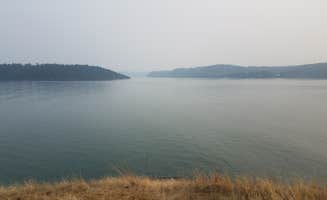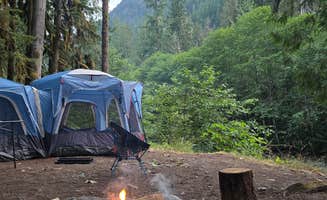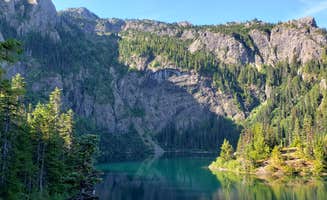Dispersed camping near Langley, Washington provides access to both coastal and mountain environments across Puget Sound and the Cascade Range. Elevation varies dramatically from sea level at island locations to over 3,000 feet in mountain areas. Sites typically receive 35-45 inches of annual rainfall with summer temperatures averaging 65-75°F during peak camping season from June through September.
What to do
Explore island trails: Hope Island Marine State Park requires boat transportation but rewards visitors with complete island exploration. "We kayaked to the island, the waters were pretty rough so I would recommend for anyone planning to stay here to look into the waters, tide and wind report the day of," advises Jess G., who also notes the island has "a trail that circles the island" with opportunities for wildlife observation.
Fish mountain streams: Mountain Loop Hway Dispersed Camp offers excellent fishing access along riverside sites. "Easy enough to access right off the mountain loop highway. Meandering sites along the river with good logs for benches and fire rings made from forest rocks. Heavily forested and beautiful," reports Jennifer H. Pack fishing gear and check local regulations for catch limits.
Hiking access to alpine lakes: Lake Angeles provides backcountry camping for hikers willing to make the trek. Luis N. explains, "Hike is about 4 miles from the trailhead with ~2,500ft of elevation gain. Trailhead is right by the toll booths for the park. Parking is limited so try to get there at a reasonable time."
What campers like
Riverside solitude: Suiattle Riverside Camp offers water-adjacent sites with natural soundscapes. Kristen Z. describes it as "so beautiful over looking a stream rushing over rocks. Ferns and big pines in the background."
Private island camping: Hope Island Marine State Park - Skagit County provides an unusual camping experience with extremely limited capacity. Raphaela H. recalls, "I was worried, with only four camping spots, that we wouldn't get one, but we ended up being the only people on the island."
Simple forest pull-outs: FR 24 offers no-frills roadside camping opportunities. "There was a handful of large pull out spots along this road. Nothing fancy and not secluded but got the job done," notes Bobby J., making these sites ideal for overnight stays during extended trips.
What you should know
Wildlife encounters: Several dispersed sites have resident wildlife requiring proper food storage. Jess G. mentions at Hope Island, "there were raccoons on the island with us but other than that we had the place to ourselves" and notes "some sea lions swimming around in the area."
Road conditions vary significantly: The Mountain Loop Highway transitions between surfaces with varying vehicle requirements. Bobby J. cautions, "After driving to North Cascades I discovered that there was real dispersed camping on that road but probably 45 minutes to an hour past where the coordinates took you. Once the highway turned into a gravel road is when I started seeing nice dispersed campsites."
Dust management: Summer months bring dry conditions affecting air quality near certain sites. Melisande M. notes about South Fork Sauk River, "many people travel too fast on it and kick up a lot of dust. This gets everywhere, so be careful of allergies and expect to clean all your gear if you're camping in the summer."
Tips for camping with families
Insect preparation: Backcountry sites often have significant insect activity requiring proper protection. Luis N. warns, "Lots of bugs so make sure to bring bug repellant" when camping at Lake Angeles, recommending appropriate clothing coverage and repellent for children.
Noise considerations: Roadside sites may experience traffic disturbance affecting sleep quality. Bobby J. found at FR 24 that "Nothing fancy and not secluded but got the job done," while at other locations, campers report highway noise being problematic.
Water safety awareness: For waterfront camping, river and marine currents present safety concerns. Jess G. recommends checking "waters, tide and wind report the day of" before attempting water crossings, particularly important when camping with children on islands or near swift-moving streams.
Tips from RVers
Limited accessibility: Most dispersed sites have restrictions limiting larger vehicles. The NF-27 Tunnel Creek area has "a big area for camp - dry camping" according to brendan, but access requires navigating "half paved and unpaved, not too bumpy" roads potentially challenging for larger RVs.
Self-contained requirements: Lack of facilities necessitates complete self-sufficiency. Nearly all dispersed sites near Langley lack hookups, water access, and waste disposal. Many require portable toilet systems and water tanks sufficient for the entire stay duration.
Parking logistics: Finding level parking at dispersed sites requires early arrival. Allie L. suggests at Mountain Loop Highway, "found a spot by the stream, parked the car to protect us. if staying longer i'd say it's best to keep going to south fork sauk." Larger vehicles should scout locations before committing to ensure adequate turning radius and exit options.




